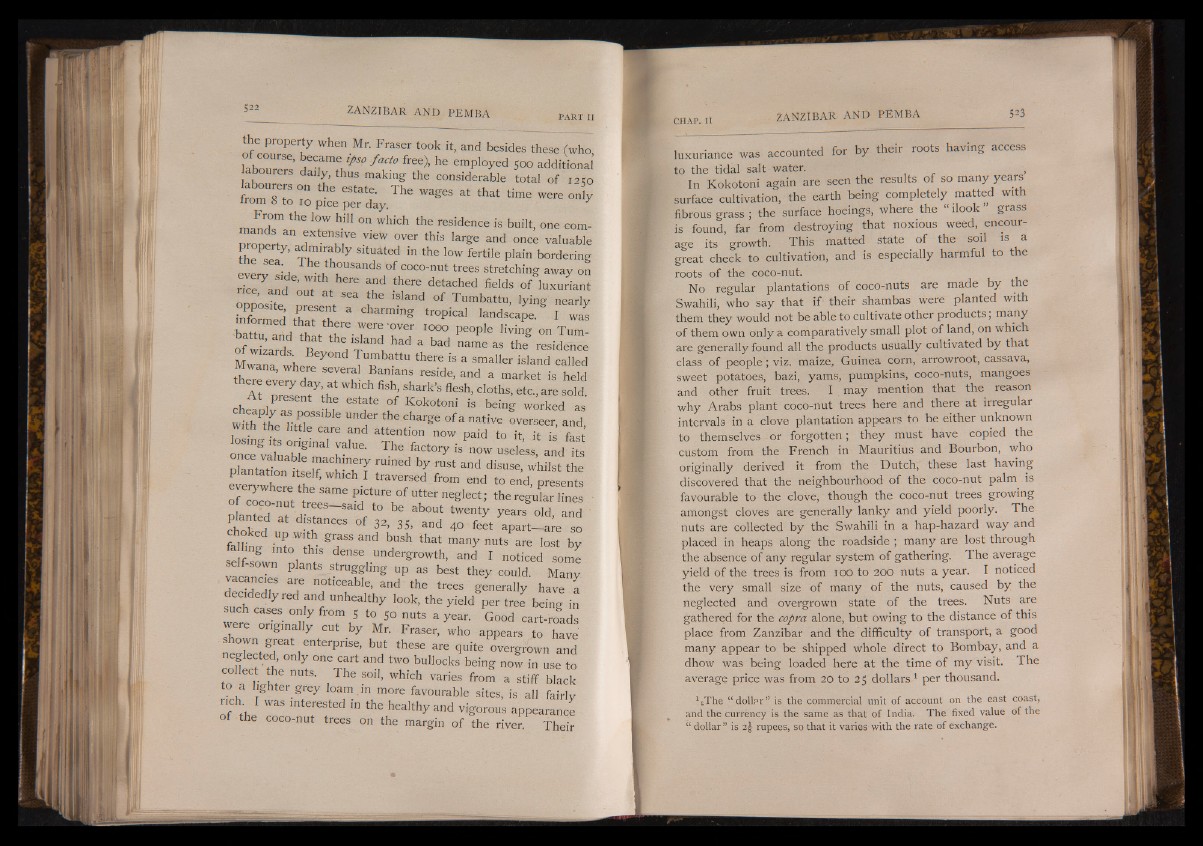
the property when Mr. Fraser took it, and besides these (who
labourers’ f acto free)> he employed 500 additional’
bourers daily, thus making the considerable total of i 2qo
labourers on the estate. The wages at that time were only
trom 8 to 10 pice per day.
mandT ^ 1(7 hil1 ° n WhlCh the residence is built, one comorooertv
"a rlX uiVe VleW OVer this large and once valuable
the ^ Sltuated * ^ e low fertile plain bordering
: thousands of coco-nut trees stretching away on
ice, and out at sea rthea islarnd <ofcf,“ Thuemd bmattu, lying nearly
pposite, present a charming tropical landscape I was
informedthat there were over too? people S ' o „ T„mt
e r t b ‘ Be the. ‘iJand, had a bad the residence
M i l \ 7 Tumbattu there is a smaller island called
Mwana, where several Banians reside, and a market is held
AAtt Tprre7s, e nt theW ehsktaht Me of Kokotofnl6i shis> dobtehinsg> m woWrked s oWas
af- P.°SSlble under tbe charge of a native overseer and
with the httle care and attention now paid to it T f a fast
oonnce «va™luabLlew mafcrhainlUeer-y r.uined' ibyf rust and disuse whailnstd thites
plantation „self, which I traversed from end to ^ p r e s e r t s
the regular lines
Plan ted « d l S ^ r o f 3° ^ aba°nd T Z ’ “ V ^
-d f S L f V T f " « , .“ "<>ergrowth, and I noticed some
self sown plants struggling up as best they could. Many
vacancies are noticeable, and the trees generally have a
decidedly red and unhealthy look, the yield per tree being in
such cases only from 5 to 50 nuts a year. Good cart-roads
were originally cut by Mr. Fraser, who appears to h a tshown
great enterprise, but these are quite overgrown and
eglected, only one cart and two bullocks being now in use to
collect the nuts. The soil, which varies from a stiff black
to a lighter grey loam.in more favourable sites, is all fairly
rich I was interested in the healthy and vigorous appearance
of -the coco-nut trees on the margin of the river. Their
luxuriance was accounted for by their roots having access
to the tidal salt water. ,
In Kokotoni again are seen the results of so many years
surface cultivation, the earth being completely matted with
fibrous grass ; the surface hoeings, where the “ ilook grass
is found, far from destroying that noxious weed, encourage
its growth. This matted state of the soil is a
great check to cultivation, and is especially harmful to the
roots of the coco-nut.
No regular plantations of coco-nuts are made by the
Swahili, who say that if their shambas were planted with
them they would not be able to cultivate other products; many
of them own only a comparatively small plot of land, on which
are generally found all the products usually cultivated by that
class of people; viz. maize, Guinea corn, arrowroot, cassava,
sweet potatoes, bazi, yams, pumpkins, coco-nuts, mangoes
and other fruit trees. I may mention that the reason
why Arabs plant coco-nut trees here and there at irregular
intervals in a clove plantation appears to be either unknown
to themselves - or forgotten; they must have copied the
custom from the French in Mauritius and Bourbon, who
originally derived it from the Dutch, these last having
discovered that the neighbourhood of the coco-nut palm is
favourable to the clove, though the coco-nut trees growing
amongst cloves are generally lanky and yield poorly. The
nuts are collected by the Swahili in a hap-hazard way and
placed in heaps along the roadside ; many are lost through
the absence of any regular system of gathering. The average
yield of the trees is from 100 to 200 nuts a year. I noticed
the very small size of many of the nuts, caused by the
neglected and overgrown state of the trees. Nuts are
gathered for the copra alone, but owing to the distance of this
place from Zanzibar and the difficulty of transport, a good
many appear to be shipped whole direct to Bombay, and a
dhow was being loaded here at the time of my visit. The
average price was from 20 to 25 dollars1 per thousand.
1feThe “ dollar” is the commercial unit of account on the east coast,
and the currency is the same as that of India. The fixed value of the
“ dollar ” is 2^ rupees, so that it varies with the rate of exchange.